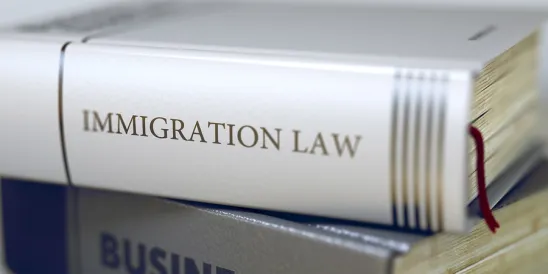California Assembly Bill (AB 450) is a bold move by the State Legislature to enter the I-9 arena – an area that has long been recognized as within the domain of the federal government. The Bill was signed by Governor Jerry Brown in October 2017 and becomes law on January 1, 2018.
The Bill amends the state Labor and Government codes and requires California employers to perform various notifications to their employees if U.S. Immigration and Customs Enforcement (ICE) audits the company’s I-9’s.
California employers should make every effort to comply to avoid stiff penalties imposed by the California Labor Commissioner. Initial penalties would be $2,000 to $5,000 per violation. Subsequent penalties would be $5,000 to $10,000 per violation.
Duties Imposed by the Bill
The bill requires California employers to do the following:
-
Bar an employer from allowing ICE to enter private areas without a judicial warrant.
-
Withhold I-9 or other employee records from ICE without a subpoena or court order.
-
Require employers to post a notice for all employees to see within 72 hours of receiving an I-9 Notice of Inspection from ICE. The notice must also be translated into other languages if the employer commonly uses those languages to communicate with their employees. The Labor Commissioner is directed to produce a template sample of the notice by January 1, 2018.
-
Provide notice to any union representing its employees within 72 hours of issuance of a Notice of Inspection.
-
Provide an employee who requests it with a copy of the I-9 Notice of Inspection.
-
Provide affected employees with a copy of ICE’s findings.
-
Refrain from re-verifying the I-9 of a current employee unless otherwise required by federal law.
-
Allow the employee to have a union representative present when meeting with the employer regarding deficiencies in their I-9 record raised through an ICE audit.
Going Forward: Practical I-9 Issues Starting January 1 in California
It has been argued that this legislation was not necessary as federal law already protects employees from arbitrary and capricious use of the I-9 process. Regardless, here’s how things will likely play out going forward:
Work Authorization: Since 1986 when the I-9 form was first introduced, the only way an employee can be terminated at the inception of employment or during an authorized reverification based on an I-9 issue is if the employee tenders documents that do not meet the federal requirements to prove up work authorization. For a list of acceptable documents to confer work authorization, see: https://www.uscis.gov/i-9-central/complete-and-correct-form-i-9
I-9 Discrimination: If employees feel that the employer is not abiding by the I-9 regulations and has experienced unlawful I-9 discrimination, they already have available to them the opportunity to complain to the U.S. Department of Justice Immigrant and Employee Rights Section (IER). In addition, California law already bars an employer from taking action against an employee who comes forward with a new, valid identity for employment purposes.
Employer Self Audits: The new California legislation makes it unlawful for an employer to reverify the I-9 of an existing employee unless required by federal law. As advised above, this would already be covered under the U.S. Department of Justice anti-discrimination regulations. And existing federal law would only allow an employer to re-verify an employee if there was actual or probable cause that the person was not work authorized, such as a Social Security mismatch letter.
Subpoena from ICE: ICE already has agency subpoena powers to issue a Notice of Inspection of I-9’s. They do not need to obtain a judicial warrant – that would be reserved for criminal investigations where more than just I-9 documents and basic corporate documents are being sought. Furthermore, ICE does not enter private areas of a company without a judicial warrant. Therefore, this new California legislation does nothing to safeguard employees from an ICE I-9 subpoena.
Notice of Technical Errors: When ICE completes an I-9 audit, usually several months go by after it collects the I-9’s, and then the agency comes back to the employer and gives it the opportunity to make technical corrections for minor errors without penalty.
If the errors were done by the employee in Section 1, then only the employee can correct those. Therefore, by definition, the employee would be notified to come into the office and make the corrections, and initial and date them.
If the errors were in Section 2 or 3 (which is only for the employer to correct) they may or may not need to involve the employee. If the error has nothing to do with the employee and his/her documents, then notification to the employee shouldn’t be necessary.
Notice of Suspect Documents: When ICE conducts an I-9 audit, and after it has given the employer the opportunity to correct the technical errors, the agency then issues a Notice of Suspect Documents, which is essentially a list of employees who ICE feels are not work authorized – usually due to the use of false documents by the employee that looked real to the employer.
The normal protocol for handling a Notice of Suspect Documents is to call each employee on the list into the office to advise the employee, explain the situation, and ask the employee if they have any new work authorization documents that the employer can show ICE. Absent a misunderstanding (i.e. someone legalized after the date of hire or their name is mistaken for someone else in the ICE database) and assuming that the employee cannot produce new valid work authorization documents, then ICE requires that the employee be terminated. This is all done with the employee’s knowledge. So once again, the California legislation does nothing to create or enhance these rights.
Confidentiality Issues: The ICE Notice of Suspect Documents usually has a long list of employee names it contends the employer should terminate after doing their own due diligence. The California legislation requires giving the employee a copy of various ICE notices that were given to the Employer. This notice will need to be partially redacted for each employee given the typical multiple names on the notice.
Notice of Intent to Fine (NIF): After the employer has made technical corrections, and terminated those on the Suspect Document List that could not show valid work authorization, ICE will then issue a Notice of Intent to Fine for the substantive violations. Any violation that is not technical is considered substantive.
Substantive errors would include a missing I-9, timeliness violations, the employer’s failure to look at the original documents, failure to record the work authorization documents, failure to sign and date the form, etc. ICE field offices around the country vary on their interpretation of what is a substantive error and their penalty posture. Regardless, the statute of limitations is 5 years from the date the substantive violation is corrected. The only exception is timeliness violations which run for 5 years from the date of hire or reverification.
Legislative Intent — Immigration is Here – Everybody
The intent of the California legislation is not entirely clear. It appears to be a political statement that the federal government cannot impose immigration restrictions on the State – basically creating a sanctuary state of sorts.
Perhaps some in the Legislature fear that in doing an I-9 audit, ICE would arrest bystanders at the company who merely look “foreign.” As a practical matter, ICE follows strict protocols when doing worksite enforcement and “round-ups” are extremely rare – and almost always tied to a serious criminal investigation.
Further, most employers are willing to comply with all laws, state and federal. At the same time, most are loathe to lose any valuable employees. The fear that employers will allow ICE free access to their facilities without warrants is thus questionable.
Perhaps the ultimate, but unstated, intent of the legislation is to give undocumented employees the “heads up” that ICE is auditing the company and to give them advance notice to find another job with another employer that hopefully won’t be audited by ICE.
Final Takeaway
Employers should comply with the new duties imposed in California by providing notice to employees within 72 hours of receipt from ICE of a Notice of Inspection. Employers should also contact counsel to make sure that all the other requirements are being followed. And prior to a Notice of Suspect Document interview with an employee, the employer should advise them that they have a right to have their union representative present (if applicable) at the meeting.




 />i
/>i

